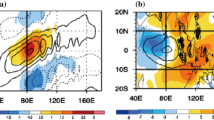Abstract
A simplified model of the moist axisymmetric Hadley circulation is examined in the asymptotic limit in which surface drag is strong and the meridional wind is weak compared to the zonal wind. Our model consists of the quasi-equilibrium tropical circulation model (QTCM) equations on an axisymmetric aquaplanet equatorial beta-plane. This model includes two vertical momentum modes, one baroclinic and one barotropic. Prior studies use either continuous stratification, or a shallow water system best viewed as representing the upper troposphere. The analysis here focuses on the interaction of the baroclinic and barotropic modes, and the way in which this interaction allows the constraints on the circulation known from the fully stratified case to be satisfied in an approximate way. The dry equations, with temperature forced by Newtonian relaxation towards a prescribed radiative equilibrium, are solved first. To leading order, the resulting circulation has a zonal wind profile corresponding to uniform angular momentum at a level near the tropopause, and zero zonal surface wind, owing to the cancelation of the barotropic and baroclinic modes there. The weak surface winds are calculated from the first-order corrections. The broad features of these solutions are similar to those obtained in previous studies of the dry Hadley circulation. The moist equations are solved next, with a fixed sea surface temperature at the lower boundary and simple parameterizations of surface fluxes, deep convection, and radiative transfer. The solutions yield the structure of the barotropic and baroclinic winds, as well as the temperature and moisture fields. In addition, we derive expressions for the width and strength of the equatorial precipitating region (ITCZ) and the width of the entire Hadley circulation. The ITCZ width is on the order of a few degrees in the absence of any horizontal diffusion and is relatively insensitive to parameter variations.
Similar content being viewed by others
References
Bretherton C.S., Sobel A.H. (2002) A simple model of a convectively-coupled Walker circulation using the weak temperature gradient approximation. J. Climate 15, 2907–2920
Burns, S.P., Sobel, A.H. Radiative feedbacks in idealized, axisymmetric simulations of the moist hadley circulation. J. Atmos. Sci. (submitted) (2006)
Fang I.M., Tung K.K. (1999) Time-dependent nonlinear hadley circulation. J. Atmos. Sci. 56(12): 1797–1807
Fang I.M., Tung K.K. (1997) The dependence of the Hadley circulation on the thermal relaxation time. J. Atmos. Sci. 53(9): 1241–1261
Fang I.M., Tung, K.K. A simple model of nonlinear hadley circulation with an ITCZ: analytic and numerical solutions. J. Atmos. Sci. 54 (10): 1379–1384; 53 (9): 1241–1261 (1996)
Gill A.E. (1980) Some simple solutions for heat-induced tropical circulaton. Q. J. R. Meteor. Soc. 106, 447–462
Held I.M., Hou A.Y. (1980) Nonlinear axially symmetric circulations in a nearly inviscid atmosphere. J. Atmos. Sci. 37, 515–533
Held I.M., Phillips P.J. (1990) A barotropic model of the interaction between the Hadley Cell and a Rossby wave. J. Atmos. Sci. 47, 856–869
Hsu C.J., Plumb R.A. (2000) Nonaxisymmetric thermally driven circulations and upper-tropospheric monsoon dynamics. J. Atmos. Sci. 57(9): 1255–1276
Kirtman B.P., Schneider E.K. (2000) A spontaneously generated atmospheric general circulation. J. Atmos. Sci. 57(13): 2080–2093
Lindzen R.S., Hou A.Y. (1988) Hadley circulations for zonally averaged heating centered off the equator. J. Atmos. Sci. 45, 2416–2427
Matsuno T. (1966) Quasi-geostrophic motions in the equatorial area. J. Meteor. Soc. Jpn. 44, 25–43
Neelin J.D., Zeng N. (2000) A quasi-equilibrium tropical circulation model-formulation. J. Atmos. Sci. 57, 1741–1766
Numaguti A. (1995) Dynamics and energy balance of the hadley circulation and the tropical precipitation zones. part II: sensitivity to meridional SST distribution. J. Atmos. Sci. 52(8): 1128–1141
Numaguti A. (1993) Dynamics and energy balance of the hadley circulation and the tropical precipitation zones: significance of the distribution of evaporation. J. Atmos. Sci. 50(13): 1874–1887
Polvani L.M., Sobel A. (2002) The Hadley circulation and the weak temperature gradient approximation. J. Atmos. Sci. 59, 1744–1752
Satoh M. (1994) Hadley circulations in radiative-ûective equilibrium in an axially symmetric atmosphere. J. Atmos. Sci. 51(13): 1947–1968
Schneider E.K., Lindzen R.S. (1977) Axially symmetric steady-state models of the basic state for instability and climate studies. Part 1. linearized calculations. J. Atmos. Sci. 34(2): 263–279
Schneider E.K. (1977) Axially symmetric steady-state models of the basic state for instability and climate studies. Part 2. nonlinear calculations. J. Atmos. Sci. 34(2): 280–296
Schneider E.K. (1983) Martian great dust storms: interpretative axially symmetric models. ICARUS 55, 302–331
Schneider E.K. (1987) A simplified model of the modified Hadley circulation. J. Atmos. Sci. 44, 3311–3328
Sobel A.H., Bretherton C.S. (2003) Large-scale waves interacting with deep convection in idealized mesoscale model simulations. Tellus 55A, 45–60
Sobel A.H. (2002) Water vapor as an active scalar in tropical atmospheric dynamics. Chaos 12, 451–459
Sobel A.H., Nilsson J., Polvani L. (2001) The weak temperature gradient approximation and balanced tropical moisture waves. J. Atmos. Sci. 58, 3650–3665
Walker C.C., Schneider T. (2005) Response of idealized Hadley circulations to seasonally varying heating. Geophys. Res. Lett. 32, L06813
Yu J.Y., Neelin J.D. (1997) Analytic approximations for moist convectively adjusted regions. J. Atmos. Sci. 54, 1054–1063
Author information
Authors and Affiliations
Corresponding author
Additional information
Communicated by R. Klein
Rights and permissions
About this article
Cite this article
Burns, S.P., Sobel, A.H. & Polvani, L.M. Asymptotic solutions of the axisymmetric moist Hadley circulation in a model with two vertical modes. Theor. Comput. Fluid Dyn. 20, 443–467 (2006). https://doi.org/10.1007/s00162-006-0024-z
Received:
Accepted:
Published:
Issue Date:
DOI: https://doi.org/10.1007/s00162-006-0024-z



